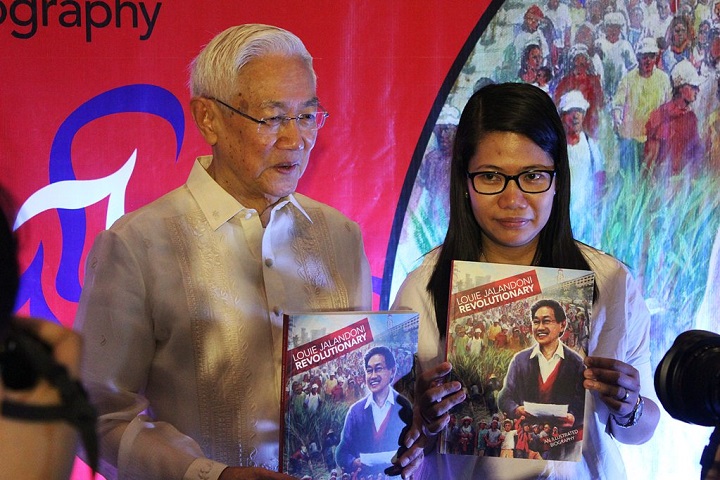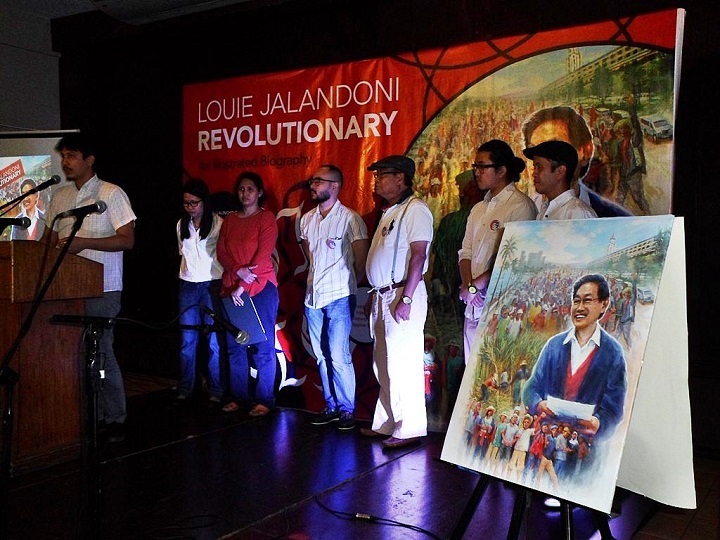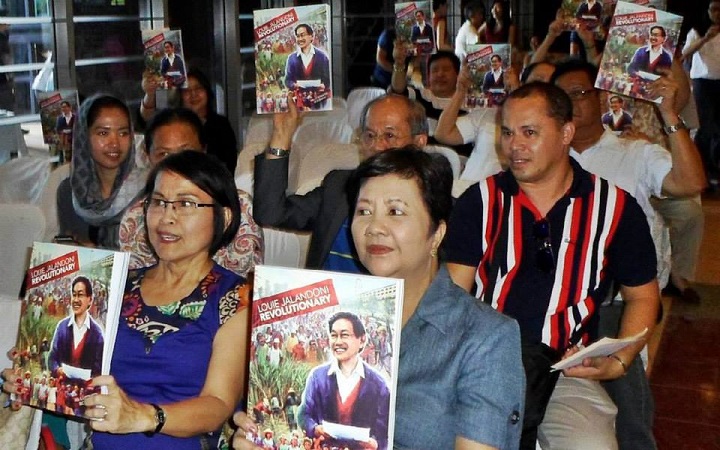
Luis Jalandoni and author Ina Alleco R. Silverio at the launch of 'Louie Jalandoni: Revolutionary: An Illustrated Biography'. Photos courtesy of Arkibong Bayan
The International Network of Philippine Studies (INPS) and Concerned Artists of the Philippines (CAP) led the launch of the graphic bio of ex-priest Luis Jalandoni, chairman of the National Democratic front of the Philippines (NDFP) panel in its peace negotiations with the Government of the Philippines (GPH).
“I was in the Netherlands in August 2010 on a personal trip with my family, and Ka Coni [Coni Ledesma of the NDFP peace panel] congratulated me on my first book ‘Ka Bel, The Life and Struggle of Crispin Beltran,’ which had come out two months before,” she said.
“We got to talking about how important it was to write about the lives of senior activists
so that lessons from their experiences fighting the Marcos dictatorship and building political mass organizations could be shared with the current generation of activists and even ordinary Filipinos,” Silverio added.
“She asked me what my next project was, and I said, well, maybe I should write about her and her husband, Luis Jalandoni.”
Workshop project

Looking back, she said one of the most crucial criticisms she received was that the narrative was too linear, too chronological. “I had to jar the reader out of complacency when reading. To do this I put in vignettes that did not follow the timeline in between chapters, and in the middle part I inserted an essay on the peace process and Ka Louie’s role in it,” she explained.
In June 2014, Silverio had a three-day session with Jalandoni to lay the finishing touches to the book. “Ang daming nawala sa book kasi I had to focus on Louie. He had so many stories about other people, mga masa na tumulong sa kanya, people who inspired him, people he looked up to. It was sometimes hard to get him back to talking about himself kasi he's so humble,” she said.
In her poetics, she mentioned, “I am writing this biography in a form of a graphic novel because I want it to come in a form that is popular. I want it to be read by the younger generation of Filipinos who are in great need of role models; I want the younger generation of Filipinos to become aware that such men as Mr. Jalandoni exist, and that they continue to give their life to the cause of national freedom and democracy.”
But UP IWP Director Butch Dalisay thought otherwise.
“I think ‘graphic novel’ would be very much a misnomer for this; first of all, it’s not a novel. We do need more biographies; we don’t know our leaders well enough; every biography is a means for us to understand ourselves,” he raised in Silverio’s panel session.
Dalisay proposed to drop the notion of a graphic novel. “It would be better if it were an illustrated biography where images would be put in certain portions. The subgenre I am proposing for this is the sympathetic biography, as opposed to the critical, more scholarly form of biography. Biography is a very ill-developed form in this country, and so they usually get commissioned by institutions. And so presumably, those biographies will be sympathetic, either for money or for political propaganda,” he explained.
Graphic novel

Gabriela partylist reps Emmi de Jesus (front, left) and Luz Ilagan and MILF peace panel member Abdullah Camlian (wearing jacket) at the book launch
The term "graphic novel" itself has been a hot topic of debate and discussion amongst the international community in recent years. In Barry Kavanagh’s interview with Alan Moore, the creator of "Watchmen", "V for Vendetta" and "From Hell", said that the term "graphic novel" is a marketing term that he never had any sympathy with. He was comfortable with the term “comic book.” In some countries, the term can also include non-fiction and anthologized work. Whatever one chooses to call it, in the
http://www.gmanetwork.com/news/story/478550/lifestyle/literature/illustrated-jalandoni-bio-could-spark-debate-on-graphic-novel

No comments:
Post a Comment
Note: Only a member of this blog may post a comment.